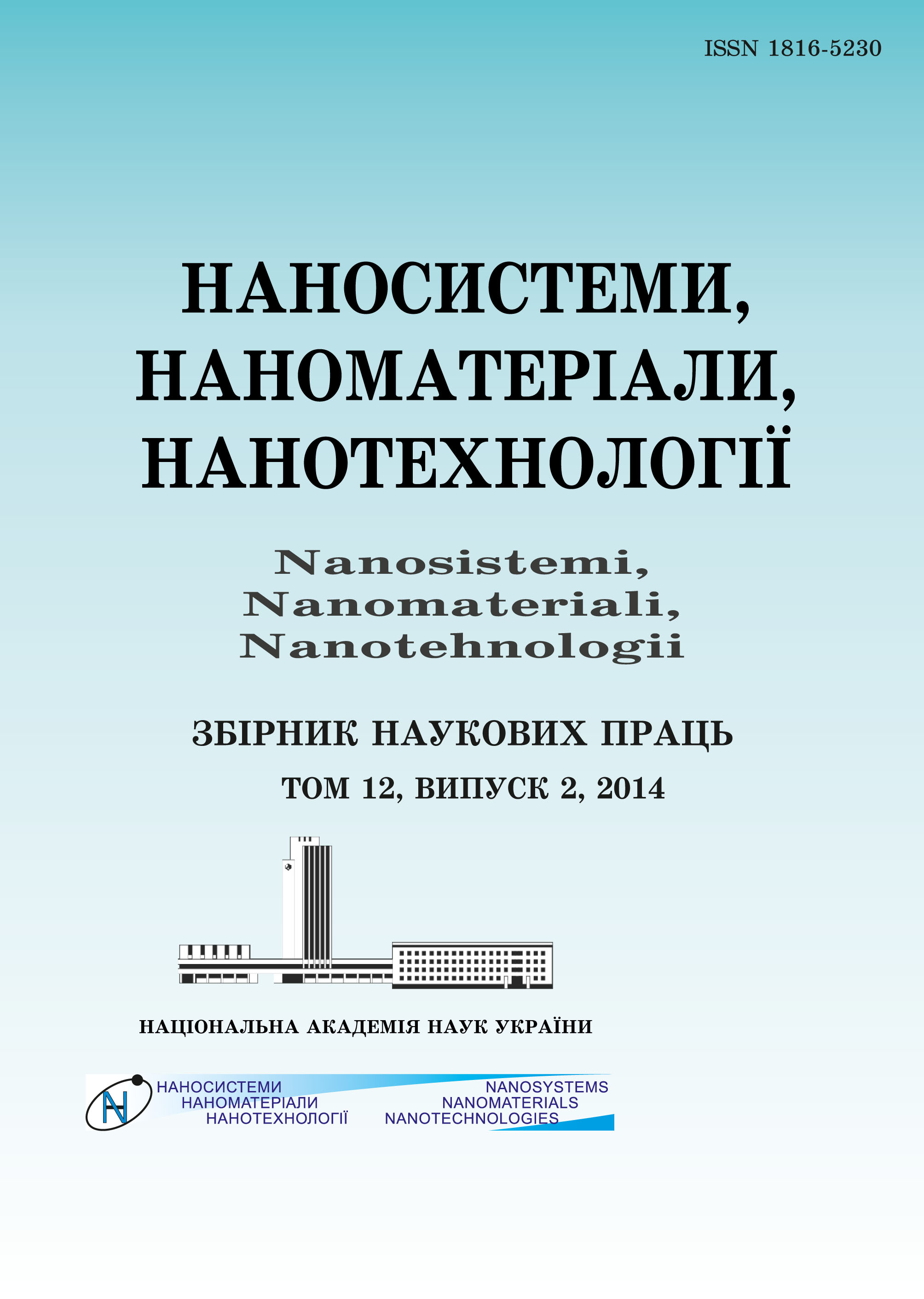|
|
|||||||||

|
Year 2024 Volume 22, Issue 4 |
|
|||||||
|
|||||||||
Issues/2024/vol. 22 /issue 4 |
|
V.G. REZANOVA and N.M. REZANOVA
Regulators of Formation and Properties of
Nanofilled Polypropylene Threads
929–942 (2024)
PACS numbers: 61.41.+e, 62.23.Pq, 81.05.Lg, 82.35.Np, 83.60.-a, 83.80.Wx, 83.85.Jn
The influence of the content of silica nanoparticles and the combined substances, namely, aluminium oxide/silica and zinc oxide/silica, on the rheological properties of the polypropylene (PP) melt and the characteristics of modified monothreads is studied. As established, the effective viscosity of PP/nanofiller compositions increases in the entire concentration range studied (0.1–3.0 wt.%) and depends on the chemical nature of the additive. In the presence of silica, the viscosity of melts increases by 20%; when mixed ZnO/SiO2 and Al2O3/SiO2 oxides are added, it increases by 30% and 50%, respectively. The elasticity of all the investigated systems decreases with increasing content of additives, judging by the indicators of jet swelling. The ability to process nanofilled compositions is improved, as evidenced by an increase in the maximum deformation of the melt jet in the longitudinal tensile field. The presence of silica nanoparticles and mixed oxides in the structure of PP monothreads improves their operational characteristics: the breaking strength and modulus of elasticity increase by 1.3–1.5 times, the percentage of strength retention in the loop and knot increases, and shrinkage decreases. Modified threads, like a polypropylene, are monolithic, have a smooth surface and are uniform in diameter along their length. Nanofillers containing a metal-oxide phase on the surface are more effective compared to the original silica
KEY WORDS: polypropylene, nanoadditives, silica, viscosity, degree of deformation, monothreads, operational properties
DOI: https://doi.org/10.15407/nnn.22.04.929
REFERENCES
- M. S. Saharudin, S. Hasbi, M. N. A. Nazri, and F. Inam, A Review of Recent Developments in Mechanical Properties of Polymer–Clay Nanocomposites (Hamburg: Springer Science and Business Media Deutschland GmbH: 2020), vol. 107; doi:10.1007/978-981-15-5753-8_11
- A. Kausar, Flame Retardant Potential of Clay Nanoparticles. Clay Nanoparticles (2020), Ch. 7, p. 169–184; doi:10.1016/B978-0-12-816783-0.00007-4
- P. Berta?ius, A. Plyushch, J. Macutkevi?, J. Banys, A. Selskis, O. Platnieks, and S. Gaidukovs, Polymers, 15, No. 4: 1053 (2023); https://doi.org/10.3390/polym15041053
- W. Khan, R. Sharma, and P. Saini, Carbon Nanotube-Based Polymer Cjmposites: Synthesis, Properties and Applications (2016); doi:10.5772/62497
- M. L. Wu, Yu. Chen, L. Zhang, H. Zhan, L. Qiang, and J. N. Wang, ACS Appl. Mater. Interfaces, 8, No. 4: 8137 (2016); https://doi.org/10.1021/acsami.6b01130
- V. Bhandari, S. Jose, P. Badanayak, A. Sankaran, and V. Anandan, Ind. Eng. Chem. Res., 61, No. 1: 86 (2022); https://doi.org/10.1021/acs.iecr.1c04203
- S. Strassburg, K. Mayer, and T. Scheibel, Physical Sciences Reviews, 7, No. 10: 118 (2019); doi.org/10.1515/psr-2019-0118
- E. Fakoori and H. Karami, The Jornal of the Textile Institute, 109, No. 9: 1152 (2018); doi:10.1080/00405000.2017.1417681
- V. P. Plavan, V. G. Rezanova, Yu. O. Budash, O. V. Ishchenko, and N. M. Rezanova, Mechanics of Composite Materials, 56, No. 3: 1 (2020); doi:10.1007/s11029-020-09883-5
- A. B. Lesbayev, B. Elouadi, B. T. Lesbayev, S. M. Manakov, G. T. Smagulova, and N. G. Prikhodko, Procedia Manufacturing, 12: 28 (2017); doi:10.1016/j.promfg.2017.08.005
- A. S. Perera, S. Zhang, S. Homer-Vanniasinkam, M. Coppens, and M. Edirisinghe, ACS Appl Mater Interfaces, 10, No. 18: 15524 (2018); doi.org/10.1021/acsami.8b04774
- D. Podstawczyk, D. Skrzypczak, X. Po?omska, A. Starga?a, A. Witek-Krowiak, A. Guiseppi-Elie, and Z. Galewski, Polym. Compos., 41, No. 11: 4692 (2020); doi:10.1002/pc.25743
- M. Shamshi Hassan, Touseef Amna, Faheem A. Sheikh, Salem S. Al-Deyab, Kyung Eun Choi, I. H. Hwang, and Myung-Seob Khil, Ceramics International, 39, No. 3: 2503 (2013); doi:10.1016/j.ceramint.2012.09.009
- Muzafar A. Kanjwal, Nasser A. M. Barakat, Faheem A. Sheikh, Woo-il Baek, Myung Seob Khil, and Hak Yong Kim, Fibers and Polymers, 11, No. 5: 700 (2010); doi:10.1007/s12221-010-0700-x
- Biswajoy Bagchi, Subrata Kar, Sumit Kr. Dey, Suman Bhandary, Debasis Roy, Tapas Kr. Mukhopadhyay, Sukhen Das, and Papiya Nandy, Colloids and Surfaces B: Biointerfaces, 108: 358 (2013); https://doi.org/10.1016/j.colsurfb.2013.03.019
- Selami Demirci, Zeynep Ustao?lu, Gonca Alt?n Y?lmazer, Fikrettin Sahin and Nurcan Ba?, Appl. Biochem. Biotechnol., 172, No. 3: 1652 (2014); doi:10.1007/s12010-013-0647-7
- M. Nazarkovsky, B. Czech, A. ?mudka, and V. M. Bogatyrov, Journal of Photochemistry and Photobiology A: Chemistry, 421: 113532 (2021); https://doi.org/10.1016/j.jphotochem.2021.113532
- M. V. Borysenko, V. M. Gun’ko, A. G. Dyachenko, I. Y. Sulima, R. Leboda, J. Skubiszewska-Ziebab, and J. Ryczkowski, Applied Surface Science, 242, Nos. 1–2: 1 (2005); https://doi.org/10.1016/j.apsusc.2004.07.064
- V. M. Bogatyrev, Ĺ. I. Oranskaya, Ě. V. Galaburda, I. I. Gerashchenko, Ň. P. Osolodchenko, and V. I. Yucypchuk, Himiya, Fizyka ta Tekhnologiya Poverhni, 7, No. 1: 44 (2016); doi:10.15407/hftp07.01.044
- N. M. Rezanova, V. P. Plavan, V. G. Rezanova, and V. M. Bohatyryov, Vlakna a Textil., 4: 3 (2016); http://vat.ft.tul.cz/Archive/VaT_2016_4.pdf
- N. M. Rezanova, V. G. Rezanova, V. P. Plavan, and O. O. Viltsaniuk, Vlakna a Textil., 2: 37 (2017); http://vat.ft.tul.cz/Archive/VaT_2017_2.pdf
- N. Ě. Rezanova, V. G. Rezanova, V. P. Plavan, and O. Î. Viltsaniuk, Functional Materials, 26, No. 2: 389 (2019); doi:10.15407/fm26.02.389
- L. S. Dziubenko, O. O. Sapianenko, P. P. Gorbyk, N. M. Rezanova, V. P. Plavan, O. A. Viltsanyuk, and R. A. Lutkovs’kyi, Nanosistemi, Nanomateriali, Nanotehnologii, 16, Iss. 2: 347 (2018); https://doi.org/10.15407/nnn.16.02.347
- V. G. Rezanova and N. M. Rezanova, Programne Zabezpechennya dlya Doslidzhennya Polimernykh System [Software for the Study of Polymer Systems] (Kyiv: Publishing House ArtEkŔ: 2020) (in Ukrainian).
- C. Han and K. Funatsu, J. Rheol., 22, No. 2: 113 (1978).
- W. J. Li, A. K. Schlarb, and M. Evstatiev, Journal of Applied Polymer Science, 113, No. 3: 1471 (2009).
- J. Gou, L. Zhang, and C. Li, Polymer Testing, 82, No. 9: 106236 (2020); https://doi.org/10.1016/j.polymertesting.2019.106236
 This article is licensed under the Creative Commons Attribution-NoDerivatives 4.0 International License ©2003—2024 NANOSISTEMI, NANOMATERIALI, NANOTEHNOLOGII G. V. Kurdyumov Institute for Metal Physics of the National Academy of Sciences of Ukraine. E-mail: tatar@imp.kiev.ua Phones and address of the editorial office About the collection User agreement |